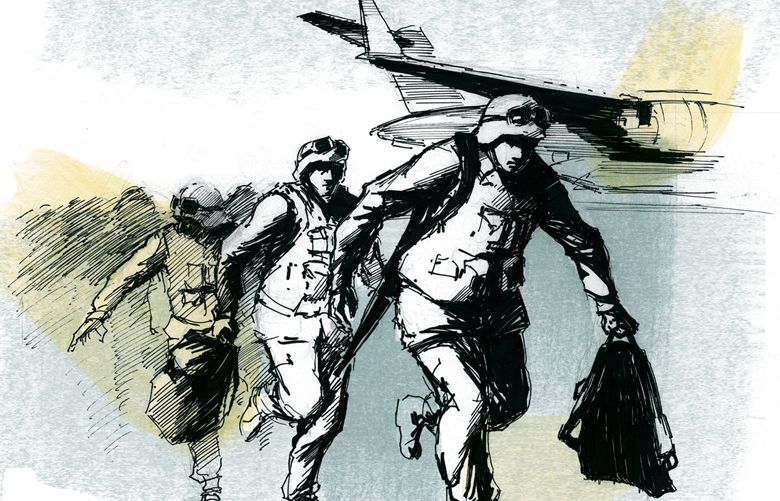In the wake of shitty domestic American fanfare — COVID surges thanks to Republican hardcore hardheadedness — the sad, shame of Afghanistan continues to unfold badly, an image of a country shattering like glass when struck with a huge, craggy rock — 20 years and we end with a terrible tale of America abroad.
Today another chapter of Vietnam relived — I thought the Taliban would score quickly once the US started to exit, but shit-dog, the timeline is horribly pathetic.
Game of unseated thrones:
 (Illustration: Op/Art by Paul Tong and found here).
(Illustration: Op/Art by Paul Tong and found here).
Final breakdown end-panic — from The Washington Post this Saturday evening:
By the middle of the week, as cities across Afghanistan were falling like dominoes to the Taliban and U.S. diplomats appeared increasingly at risk, President Biden’s plan for an orderly end to the United States’ longest war was quickly falling apart.
On Wednesday evening, Biden convened his top advisers to assess the ominous turn of events.
One by one, in the cramped Situation Room in the White House basement, national security adviser Jake Sullivan, Defense Secretary Lloyd Austin and Secretary of State Antony Blinken outlined the administration’s options for ensuring the security of U.S. personnel.
Biden asked them to return with recommendations.When the aides reconvened early the next morning, things had gotten worse.
The Taliban was taking control of more and more of Afghanistan’s 34 provincial capitals, most of them seized without a major fight, and the militants were bearing down on Kabul, the national capital.
After being briefed by Sullivan and Austin, Biden gave the order to activate a plan deploying troops to secure the Kabul airport and create an evacuation route for Americans on the ground.
…
The urgency bordering on panic laid bare how the president’s strategy for ending the 20-year U.S. military effort — leaving Afghan forces to hold off the Taliban for months as negotiators redoubled efforts to hammer out a peace deal — has undergone a rapid dismantling.The lightning collapse is rooted in misplaced assumptions — including a failure to account for how the U.S. departure would catalyze a crisis of confidence in Afghan leaders and security forcers, enabling the Taliban blitz — from the moment Biden announced the withdrawal this spring.
It is equally the product of two decades of miscalculations about transforming Afghanistan and overly optimistic assessments of progress that have plagued the war from its start.
And not to account for the $83 billion spent by America over 20 years. Today another higher human price embedded in massacre:
God help the people there, especially the Hazaras. In 1998, the Taliban massacred several thousand civilians in Mazar-e-Sharif and left many of their bodies to rot unburied in the sun and be eaten by dogs. https://t.co/T1PBSlrExj https://t.co/LV736tXSDR
— Mehdi Hasan (@mehdirhasan) August 14, 2021
And a tragic domino, too — via The New York Times this afternoon:
The last major city in northern Afghanistan fell to the Taliban on Saturday night, marking the complete loss of the country’s north to the Taliban as the insurgents appear on the verge of a full military takeover.
The collapse of Mazar-i-Sharif, the capital of Balkh Province and one of the last three major cities that had remained under government control, comes just a day after two key cities in southern and western Afghanistan were lost to the Taliban.
The Taliban seized the last northern holdout city barely an hour after breaking through the front lines at the city’s edge. Soon after, government security forces and militias fled — including those led by the infamous warlords Marshal Abdul Rashid Dostum and Atta Muhammad Noor — effectively handing control to the insurgents.“Government forces and popular uprisings all left the city,” said Hashim Ahmadzai, a pro-government militia commander.
“The Taliban seized government and military buildings. There was no resistance.”The insurgents now effectively control the southern, western and northern regions of the country — just about encircling country’s capital, Kabul, as they press on in their rapid military offensive.
The Taliban blitz began in May, but the insurgents have managed to seize more than half of Afghanistan’s provincial capitals in just over a week.
…
The loss of the north — once the heart of resistance to the insurgents’ rise to power in 1996 — to the Taliban offered a devastating blow to morale for a country gripped with panic.
In the late 1990s, Mazar-i-Sharif was the site of pitched battles between the Taliban and northern militia groups that managed to push back the hard-line insurgents before the group took over the city in 1998.
The victory followed infighting and defections among the militias and culminated with the Taliban’s ethnically charged massacre of hundreds of militia fighters who had surrendered.
Horror-hellscape ahead. A portion of the Human Rights Watch summary (November 1998) on the massacre at Mazar-i-Sharif:
In the days that followed, Taliban forces carried out a systematic search for male members of the ethnic Hazara, Tajik, and Uzbek communities in the city. The Hazaras, a Persian-speaking Shi’a ethnic group, were particularly targeted, in part because of their religious identity.
During the house-to-house searches, scores and perhaps hundreds of Hazara men and boys were summarily executed, apparently to ensure that they would be unable to mount any resistance to the Taliban.
Not much has changed with the Taliban in the past 23 years (CBS News): ‘The U.S. Embassy in Kabul said Wednesday that it was hearing reports of the Taliban executing some surrendering Afghan troops, as the extremist group captured its 10th provincial capital in a week … The U.S. Embassy said the reported executions of surrendering Afghan troops were “deeply disturbing” and “could constitute war crimes.”‘
All downhill from here.
 (Illustration out front: Salvador Dalí’s 1958 painting, “Meditative Rose,” found here).
(Illustration out front: Salvador Dalí’s 1958 painting, “Meditative Rose,” found here).